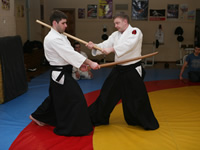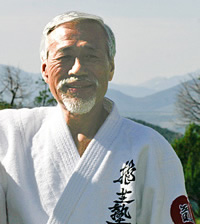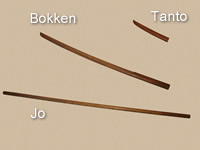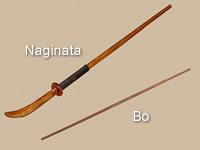Weapons in aikido
Demonstration of work with weapons
Work with jo
Tanto no kata
Purposes of trainings with weapons
 In Aikido great attention is paid to weapons.
In Aikido great attention is paid to weapons.
But why should we practice Aikido with old-fashioned weapons (bokken, jo, tanto), which are probably useless these days? The matter is that such trainings allow quick acquiring of skills which are the most important for Aikido. It is very difficult to acquire these skills having nothing in your hands.
- First of all weapons allow correct stance development. Correct stance in Aikido is required for fast movements, balance control and even for correct breath. Thus, correct stance in Aikido allows you to spend your energy more economically in a fight.
- Secondly, trainings with weapon allow you to develop understanding of a correct distance. Without weapons trainees often cannot define correctly the optimum distance from their partner. But when the partner has a bokken in his hands the trainee unconsciously perceives this as a potentially bigger threat and as a result he tries to keep at such a distance at which it is possible to control the partner, but at the same time not to give him a chance to hurt you.
- Thirdly, trainings with weapons develop a feeling of timing. Timing is an ability to select the correct moment to react to partner' actions, to catch the moment when it is necessary to intercept uke force for effective counterattack. Also the feeling of timing includes the ability to move synchronously with the attacker, not advancing his actions and not lagging behind him.
 Fourthly, weapons in Aikido equalize capabilities of opponents. M. Saotome said: "Suppose you are a big strong man. But a small woman, whom you threw over the floor-mat with such a pleasure, can bit you if she has a bokken in her hands. Big weight which added to your technique without weapon can now slow down your movements while her movements will be fast and precise. Your emphasis on development of muscular force can hinder development of reaction, precision and intuition which she could develop in herself for the lack of possibility to increase weight and power".
Fourthly, weapons in Aikido equalize capabilities of opponents. M. Saotome said: "Suppose you are a big strong man. But a small woman, whom you threw over the floor-mat with such a pleasure, can bit you if she has a bokken in her hands. Big weight which added to your technique without weapon can now slow down your movements while her movements will be fast and precise. Your emphasis on development of muscular force can hinder development of reaction, precision and intuition which she could develop in herself for the lack of possibility to increase weight and power".
Types of weapons used for trainings
 For Aikido trainings the following types of weapons are used: bokken, jo, tanto.
For Aikido trainings the following types of weapons are used: bokken, jo, tanto.
- Bokken (or bokuto) is a wooden model of Japanese sword (katana). For the first time bokken was used by swordsman Miyamoto Musashi (1584 – 1645) for trainings and fights not to kill the rivals. However, skillfully inflicted blow of bokken can lead to death.
- Jo is a light, smooth wooden pole with a length of 130 cm which is used in many Japanese martial arts including Aikido. Jo is applied for making direct poking blows and chop down blows at the body and legs, and it is also used for blocking.
- Tanto is a Samurai dagger. Tanto is generally used as picking weapon though it can be used as cutting as well.
 For Katori Shinto-ryu trainings the following types of weapons are used: bokken, naginata and bo.
For Katori Shinto-ryu trainings the following types of weapons are used: bokken, naginata and bo.
- Naginata is a Japanese halberd. Literally a naginata means a "long sword". It has a blade 30 cm long fitted on a long (about 2 m) handle. When fighting, the naginata gives more possibilities than a spear or a sword, as the naginata technique combines both a spear techniques and that of a sword. It is possible not only to prick and cut with it, but also to hack, strike blows, and parry the rivals' attacks.
- Bo is a wooden or a bamboo staff which is more than 180 cm long. A bo length is chosen individually according to a person's height. For the military purposes the ends of a bo were often narrowed and fettered with metal.
See also